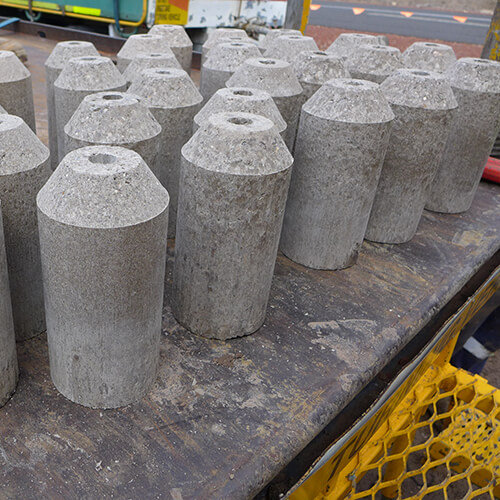A Queensland research project has trialled an innovative new environmental technology which could further improve the way unused coal, mineral, oil and gas wells and water bores are sealed off. A specially engineered bentonite plug is showing potential as an even more effective and permanent seal of bores than the cement-based plugs used currently. Bentonite is a fairly common form of clay which can be sourced locally in Queensland.
The plug’s development is the result of ground-breaking research made possible by a large collaborative partnership which bought together a broad collaboration of government, industry and technical specialists to work on the novel technology.
a common clay which can be sourced
in Queensland, is being trialled to test
if the technology can improve
the way unused bores are sealed off
An extensive research and laboratory testing program worked on optimising the composition and shape of the plug to maximise performance.
The research effort was led by The University of Queensland Centre for Coal Seam Gas, a university-industry partnership between The University of Queensland, APLNG, Arrow Energy and Santos. Former Centre member Shell/QGC also supported this project. Industry partners contribute funding to the Centre for multi-party research in optimising coal seam gas. This project also attracted vital backing of an Advance Queensland Innovation Partnership grant.
The plug has now been trialled thanks to a proactive partnership between the Queensland Government Department of Natural Resources, Mines and Energy (DNRME), The University of Queensland Centre for Coal Seam Gas and private companies Nautec and Renviro. DNRME managed the field operation with Dynamic Drilling (Aust) Pty Ltd providing drilling services. The trial was conducted at an old coal exploration borehole just out of Chinchilla. The bore had been marked for sealing due to higher than expected methane levels recorded at the surface, making it ideal site for the trial. It was the plug’s second run in the field, following on from a successful initial trial at a water monitoring well near the Shell/QGC’s Bellevue coal seam gas field near Miles, Queensland in 2016.

gone into optimising the composition
and shape of the plug to maximise
performance
The trial used approximately 500 plugs (each 19cm in length) to seal the coal exploration hole. It involved re-drilling the coal borehole to its full depth of approximately 114 metres and filling it with the bentonite and a gas-tight impermeable grout.
It was the first time the plugs had been used in combination with the special grout formulated by Nautec. The grout has been specially designed to flow into small cavities and cracks in rock formations and provide a gas-tight seal. It was mixed on site by Renviro.
Director of The University of Queensland Centre for Coal Seam Gas, Professor Andrew Garnett, says that the trial successfully tested the main advantage of the bentonite plug – its ability to ‘re-heal’ after any physical disturbance.
“Initial testing showed it actually increased in sealing performance during the healing process,” says Professor Garnett. “While ultimately, we would like more field trials to cover many potential uses, this trial has proved an excellent start and has only been made possible by the Advance Queensland initiative and the forward thinking of the Department,” he says.
More information
- For more information about the trial please contact The University of Queensland Centre for Coal Seam Gas Prof Andrew Garnett Director on ccsg@uq.edu.au
- The site of the trial is a coal bore adjacent to Greenswamp Road (about 15 kilometres south-west of Chinchilla)
- The project site is being managed under the Queensland Government’s Department of Natural Resources, Mines and Energy’s, under its Abandoned Mine Lands Program, which assesses abandoned and legacy mine sites and reduces significant public health and safety risks
- To see the Department of Natural Resources, Mines and Energy update click here



